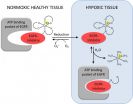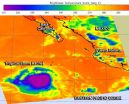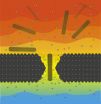(Press-News.org) This news release is available in German.
An interdisciplinary team of researchers from the University of Vienna (Institute of Inorganic Chemistry) and the Medical University of Vienna (Institute for Cancer Research) has successfully developed a new strategy for reducing the often serious side effects of an important class of modern anticancer drugs (tyrosine kinase inhibitors). The novel drug is supposed to restrict its activity with high selectivity to the malignant tumour.
The occurrence of severe side effects and the development of resistance are two of the biggest problems facing modern cancer therapy. Even the latest, highly targeted cancer drugs such as the tyrosine kinase inhibitors Tarceva¿ or Sutent¿ are affected by these problems, which can ultimately lead to treatment having to be stopped. The effect of this class of inhibitors is based on the specific inhibition of proteins that are over-activated in cancer cells and which drive abnormal cell growth. However, clinical practice has shown that, as a result of the physiological functions of these proteins in healthy tissue, their inhibition can cause severe side effects. As a result, there is an acute need for strategies to restrict the effect of these highly promising new drugs more selectively to the malignant tumour.
The aim of the research was to develop an improved tyrosine kinase inhibitor that is actually inactive and which is only activated selectively in the malignant tissue. This is intended to prevent damage to healthy tissue and therefore minimise side effects for patients. As part of the paper published in the highly respected journal "Angewandte Chemie [Applied Chemistry], International Edition", a new inhibitor has been successfully synthesised and coordinated to cobalt(III). This leads to initial drug inactivation and, thus, no activity under normal physiological conditions. Only in tumour tissue where, due to the rapid growth, unusually low-oxygen conditions prevail, the inactive cobalt(III) compound is reduced to cobalt(II) and as a result releases the active drug. The tumour-selective effectiveness of this approach has been demonstrated both in living cells and in tumor-bearing organisms.
The development of this complex idea and strategy was made possible by the outstanding interdisciplinary collaboration organised in the context of the "Translational Cancer Therapy Research" platform led by Bernhard Keppler, Dean of the Faculty of Chemistry at the University of Vienna, and Walter Berger, Professor at the Medical University of Vienna. This research platform promotes constant scientific exchange between synthetic chemists at the University of Vienna and cancer researchers at the Medical University of Vienna. It is only through these opportunities that the team of university assistants Christian Kowol (University of Vienna) and Petra Heffeter (Medical University of Vienna) has been able, based on two diploma theses (by Claudia Karnthaler-Benbakka, MSc., and Diana Groza, MSc.), to produce these results. The study was funded by the City of Vienna fund for "innovative interdisciplinary cancer research", the Austrian Science Fund (FWF) and COST CM1105. In view of the highly promising results, the new combination class has been patented by the two universities and currently a partner for further (clinical) development is searched.
So far there has been no comparable strategy for reducing the (severe) side effects of tyrosine kinase inhibitors. As a result, there is hope that, in future, the approach presented here will improve the tolerance of the therapy and allow this treatment to benefit patients who have previously had to discontinue it.
INFORMATION:
Publication in "Angewandte Chemie, International Edition":
Tumor-Targeting of EGFR Inhibitors by Hypoxia-Mediated Activation: C. Karnthaler-Benbakka, D. Groza, K. Kryeziu, V. Pichler, A. Roller, W. Berger, P. Heffeter and C. R. Kowol. 2014.
DOI: 10.1002/anie.201403936 END
Strategy to reduce side effects in modern cancer therapy
2014-09-26
ELSE PRESS RELEASES FROM THIS DATE:
Sensitive youngsters
2014-09-26
Young individuals of a species are often more sensitive towards environmental stress than their adult counterparts. Scientists from GEOMAR Helmholtz Centre for Ocean Research Kiel now observed this effect in the sea star Asterias rubens from the Baltic Sea. In a long-term laboratory experiment that was conducted in the framework of the German research network BIOACID (Biological Impacts of Ocean Acidification), the researchers simulated three different levels of acidification that could be reached in the Baltic Sea by the uptake of additional carbon dioxide (CO2) within ...
Study identifies unexpected clue to peripheral neuropathies
2014-09-26
CINCINNATI – New research shows that disrupting the molecular function of a tumor suppressor causes improper formation of a protective insulating sheath on peripheral nerves – leading to neuropathy and muscle wasting in mice similar to that in human diabetes and neurodegeneration.
Scientists from Cincinnati Children's Hospital Medical Center report their findings online Sept. 26 in Nature Communications. The study suggests that normal molecular function of the tumor suppressor gene Lkb1 is essential to an important metabolic transition in cells as peripheral nerves (called ...
NASA identifies cold cloud tops in Tropical Storm Rachel
2014-09-26
NASA's Aqua satellite saw the area of strong thunderstorms with colder cloud tops had grown within the Eastern Pacific Ocean's Tropical Storm Rachel.
NASA's Aqua satellite passed over the large Tropical Storm Rachel on Sept. 25 at 4:41 p.m. EDT and the Atmospheric Infrared Sounder or AIRS instrument, saw that the extent of colder cloud tops had increased, indicating thunderstorm heights were increasing and it was strengthening. The expansion of those stronger thunderstorms also suggests that the northeasterly wind shear may be relaxing a little. The strongest thunderstorms ...
Underwater robot for port security
2014-09-26
Last week, at the International Conference on Intelligent Robots and Systems, MIT researchers unveiled an oval-shaped submersible robot, a little smaller than a football, with a flattened panel on one side that it can slide along an underwater surface to perform ultrasound scans.
Originally designed to look for cracks in nuclear reactors' water tanks, the robot could also inspect ships for the false hulls and propeller shafts that smugglers frequently use to hide contraband. Because of its small size and unique propulsion mechanism — which leaves no visible wake — the ...
Penn team studies nanocrystals by passing them through tiny pores
2014-09-26
An interdisciplinary team of University of Pennsylvania researchers has now applied a cutting-edge technique for rapid gene sequencing toward measuring other nanoscopic structures. By passing nanoscale spheres and rods through a tiny hole in a membrane, the team was able to measure the electrical properties of those structures' surfaces.
Their findings suggest new ways of using this technique, known as "nanopore translocation," to analyze objects at the smallest scale.
The research was led by Marija Drndić, professor in the Department of Physics and Astronomy ...
Geisel researchers contribute to study of trained immunity
2014-09-26
Hanover, NH - A study published in the journal Science provides support for a new—and still controversial—understanding of the immune system. The research was conducted by collaborators in the U.S. and Europe, including Robert Cramer, PhD, an assistant professor of microbiology and immunology at the Geisel School of Medicine and member of the Dartmouth Lung Biology Center, and Kelly Shepherdson, PhD, at the time a graduate student in Cramer's lab.
Typically, scientists divide the immune system into two categories: the innate immune response and the adaptive immune response. ...
New UT Dallas technology may lead to prolonged power in mobile devices
2014-09-26
Researchers from The University of Texas at Dallas have created technology that could be the first step toward wearable computers with self-contained power sources or, more immediately, a smartphone that doesn't die after a few hours of heavy use.
This technology, published online in Nature Communications, taps into the power of a single electron to control energy consumption inside transistors, which are at the core of most modern electronic systems.
Researchers from the Erik Jonsson School of Engineering and Computer Science found that by adding a specific atomic ...
High-throughput cell-sorting method can separate 10 billion bacterial cells in 30 minutes
2014-09-26
University of Hawaii at Manoa College of Engineering mechanical engineer Yi Zuo has developed a new, high-throughput method for sorting cells capable of separating 10 billion bacterial cells in 30 minutes.
The finding has already proven useful for studying bacterial cells and microalgae, and could one day have direct applications for biomedical research and environmental science—basically any field in which a large quantity of microbial samples need to be processed.
The new method was described in a September 2014 publication in the scientific journal Analytical Chemistry, ...
New scientific review of genetically engineered feeds in livestock diets
2014-09-26
An article published in the peer-reviewed Journal of Animal Science concludes feeding livestock diets that contain genetically engineered (GE) crops has no impact on the health or productivity of those animals. In a thorough review of scientific literature and field data sets, the article documents evidence that the performance and health of food-producing animals fed GE crops are comparable with those of animals fed non-GE crops.
Since their introduction in 1996, GE feed crops have become an increasing component of livestock diets. Today, more than 95 percent of U.S. ...
Experts call for widening the debate on climate change
2014-09-26
Environmental scientists are being urged to broaden the advice they give on global climate change, say experts who are also frustrated that decision makers are not taking enough action.
Writing in the journal Nature Climate Change, The University of Manchester researchers argue that scientists are expressing a strong desire to fix the problems highlighted by their studies into human-induced climate change
The authors suggest there are problems with environmental scientists offering practical solutions that can help societies adapt to a fast-changing Earth - one where ...




